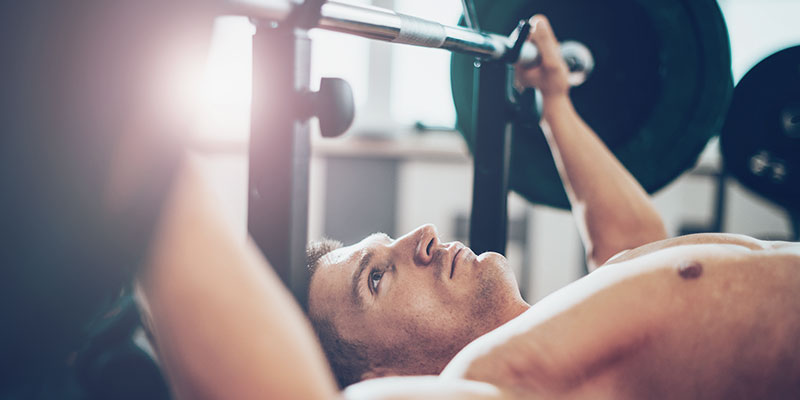Are you a seasoned lifter who’s grown tired of traditional bodybuilding rep schemes? We’ve got something for you.
If you’ve been training for years following the 8 to 12 reps with 70% to 80% of 1RM-rep max rule, you’ve probably made some pretty decent gains. After all, 4 sets of 8 gives you 32 reps; 3 sets of 12 has you doing 36 reps – which is a pretty decent volume for a single exercise. But what if I told you that following this rep strategy has been cheating you out of gains? That’s right – while the program above is certainly adequate, it lacks intensity – you waste energy increasing your weights by increments and at the end of the workout spend too many reps moving submaximal weight that doesn’t stimulate enough high-threshold motor units (HTMUs)/fast-twitch fibers. But what if you could lift the heaviest weights you can normally only lift for a few reps for more reps than you previously thought possible – you’d surely have even bigger muscles, right?
That’s where cluster sets come into play. A cluster set is a set of reps broken down into smaller “clusters” that are separated by built-in “intra set” rest periods with the end result being more weight, more reps and more total tonnage lifted! Like rest-pause training, cluster sets take advantage of your body’s ability to replenish explosive PCr (phosphocreatine) energy stores quickly, but unlike rest-pause, your level of fatigue doesn’t dictate the volume or the load – and more importantly you don’t lift lighter weights. Cluster sets simply allow you to perform more work than you’d normally be capable of at a given weight.
Typically, a cluster set would consist of using 90% of your 1-rep max (1RM) or a weight you can lift 3 times, and lifting it once – with a 10-second rest between reps – until you hit 4,5 or even 6 reps. Other strategies can consist of 2 to 3 reps with longer rest times in between.
A Twist on Cluster Sets – Cluster-Drop Sets
For our cluster set plan, though, instead of sticking to one weight, we’re tacking on a drop set at the end.
Why? Adding a drop set increases the time under tension/load of the set and the metabolic stress of the set – two key factors that influence muscle hypertrophy. After all – our goal is to be as big as possible, right? Well, remember, there’s a strong relationship between mTOR signaling, the production of local growth factors and maximal motor unit recruitment. Metabolic stress in the muscle signals adaptation and can increase satellite cell activation as well as activation of the mTOR pathway, which in turn means increased protein synthesis and muscle size. That’s where the drop set comes in, as a drop set ensures you’ve not just trained the muscle fibers, but fatigued them – releasing the local growth factors needed to make them grow.
Warm-Up
Before you start your first set, ensure you’re properly warmed up. Warm up with a very light weight or even just the bar. The goal here is to fire up your nervous system to move some serious weight without fatiguing your muscles.
Working Sets
Starting Weight: 85-90% of your 1RM. This is key, and it’s important to keep the load as high as possible.
- 1 rep (rest for 10 seconds)
- 1 rep (rest for 10 seconds)
- 1 rep (rest for 10 seconds)
- 1 rep (rest for 10 seconds)
1 rep, no rest – this where the drop set comes into play, and you or your training partner quickly strip off the weight to 50% of your 1RM and you proceed to hit 8 more reps (to failure) without a pause – this means no locking out, no breathers, no rest-pause. If you can do more than 8, you’ve taken too much weight off.
Done? Good. Rest for 2 minutes, and repeat this twice more. You may find hitting 8 reps on the third set to be very difficult – and if that’s the case, avoid the urge to drop the weight. Simply get as many reps as you can, and aim to improve on each subsequent workout.
When to use Cluster-Drop Sets
Limit the use of these cluster sets to your key multi-joint compound exercises. So if you’re training chest, use these cluster drop sets for the bench press, incline bench and dumbbell presses; and then for your single joint exercises, like triceps extensions, go back to using your normal sets and reps.
Helpful Supplements
Creactor® and Clear Muscle™ are two ideal supplements to be on for this type of training.
Creatine works by increasing the availability of an energetic molecule called phosphocreatine (PCr), which your body will draw upon during these cluster sets. Increasing the storage pool of phosphocreatine in your muscles will enhance the resynthesis of phosphocreatine and ATP production during recovery.
Clear Muscle triggers an increase in anabolic protein synthesis in the muscles, while at the same time, it inhibits muscle catabolism. This unique and powerful ability makes it extremely valuable for athletes like hardcore bodybuilders who are you looking to grow as fast as possible by training as frequently as possible.








